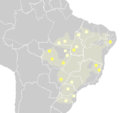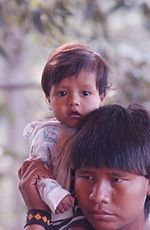Kĩsêdjê (Suyá, Kĩsêdjê: Khĩsêtjê kapẽrẽ [kʰĩˈsedʒe kaˈpẽɽẽ]) is a Northern Jê language (Jê, Macro-Jê) spoken in Mato Grosso, Brazil. It is closely related...
18 KB (1,415 words) - 21:04, 19 April 2025
The Suyá, self-denomination Kisêdjê, are indigenous people in Brazil, at the headwaters of the Xingu River. Historically, they were known for their lip...
6 KB (721 words) - 18:45, 27 August 2023
Suya is a West African shish kebab dish. Suya may also refer to: Suyá, an indigenous people of Brazil Suyá language, the language of the Suyá people Suyá...
382 bytes (77 words) - 11:10, 4 November 2022
Suya, also known as Tsire, is a traditional Hausa (Nigerian) smoke-grilled spiced meat on skewer. Suya is generally made with thin-sliced spiced beef,...
7 KB (773 words) - 22:30, 31 March 2025
Mẽbengokre (Kayapó) (8,638 speakers) Panará (Kreen Akarore) (380 speakers) Suyá (350 speakers) Timbira (Canela-Krayô, with the Canela and Kreye dialects)...
28 KB (535 words) - 20:53, 4 May 2025
Suyá music is the music of the Suyá people, a tribe of about 150[citation needed] people who live on the Suyá-Miçu River and are native to Mato Grosso...
11 KB (1,550 words) - 22:26, 16 April 2024
Nahukuá, Suyá, Trumai, Wauja and the Yawalapiti peoples. They have many cultural similarities despite their different ethnicity and language groups. Xingu...
13 KB (1,448 words) - 14:58, 24 May 2025
Boletim do Museu Paulista, Documentação Lingüística, 2:1–62. Nonato, R.; Suyá, J.; Suyá, K. (2012). Dicionário Kĩsêdjê-Português. Rio de Janeiro: Museu do Indio...
19 KB (1,618 words) - 20:28, 19 April 2025
The Tagalog language, encompassing its diverse dialects, and serving as the basis of Filipino — has developed rich and distinctive vocabulary deeply rooted...
168 KB (9,733 words) - 09:54, 24 May 2025
The Tapajós: 7 (also called Suyá and Trans-Xingu: 535 ) languages are a close-knit group of the Northern Jê languages, which comprises Kĩsêdjê and Tapayúna...
7 KB (369 words) - 21:04, 19 April 2025
Ventureño is a member of the extinct Chumashan languages, a group of Native American languages previously spoken by the Chumash people along the coastal...
12 KB (957 words) - 02:23, 1 January 2025
continuum, as follows: Canela-Krahô ↔ Gavião-Krĩkati ↔ Apinajé ↔ Kayapó ↔ Suyá-Tapayuna ↔ Panará-Kayapó do Sul Apart from Kapiekran, all Krao varieties...
6 KB (525 words) - 21:04, 19 April 2025
Cíntia Karla Coelho (2011). "Comparando as consoantes das línguas Tapajúna e Suyá". Alfa: Revista de Linguística. 55 (2): 601–11. doi:10.1590/S1981-57942011000200011...
18 KB (1,377 words) - 16:57, 1 June 2025
Tapayuna people (category CS1 Portuguese-language sources (pt))
The Tapayuna (autonym: Kajkwakratxi), also known as Tapayúna, Western Suyá and Beiço-de-Pau are an indigenous people native to the state of Mato Grosso...
4 KB (324 words) - 21:14, 11 December 2024
Bariba, also known as Baatonum, is the language of the Bariba people and was the language of the state of Borgu. The native speakers are called Baatombu...
20 KB (685 words) - 10:21, 21 March 2025
Ethnicity (category Articles with French-language sources (fr))
Michael Sletcher, ed., New England, (Westport, CT, 2004) Seeger, A. 1987. Why Suyá Sing: A Musical Anthropology of an Amazonian People, Cambridge, Cambridge...
89 KB (10,167 words) - 17:18, 29 May 2025
Hausa people (category Articles with French-language sources (fr))
of West Africa and balangu or gashi. A dried version of Suya is called Kilishi. Hausa Language has been written in modified Arabic script, known as Ajami...
71 KB (7,707 words) - 06:24, 30 May 2025
as far south as Paraguay. They include the Timbira, the Kayapó, and the Suyá of the northwestern Jê; the Xavante, the Xerente, and the Akroá of the central...
2 KB (99 words) - 13:29, 4 October 2024
(SBB) languages are the major branch of the Central Sudanic language family with about forty languages. Principal groups include Bagirmi languages such...
16 KB (1,059 words) - 17:39, 29 May 2024
Yawalapiti (section Language)
with Kiabi, Yudja and Suya tribes. The ways of life of these four tribes are quite similar despite having different languages. Their villages are situated...
4 KB (405 words) - 16:01, 13 April 2024
continuously being attacked by the native communities in the region, including the Suyá and Ikpeng. Following a period of contacts from researchers, including Buell...
30 KB (3,785 words) - 00:08, 11 May 2025
or Kratke Range languages are a family of the Trans–New Guinea languages in the classification of Malcolm Ross. The Angan languages are clearly valid...
10 KB (472 words) - 10:46, 4 August 2024
Xingu Indigenous Park (category Articles with Portuguese-language sources (pt))
the park (Lower Xingu) are: Trumai Jê languages Suyá Tupian languages Juruna (Yudja) Kayabi Cariban languages Ikpeng (Txikão) In the northern park of...
15 KB (1,725 words) - 15:34, 9 October 2024
Pekodian languages are: Bakairi Ikpeng Pará Arára Yarumá (Suyá) Amonap (Kuikuro–Kalapalo, Matipuhy) Carvalho classifies the Pekodian languages as follows...
5 KB (446 words) - 21:40, 15 December 2024
(Cayapó, Kokairmoro) (dialects: Xikrin (Xukru, Diore), Kararaó, Kayapó-Kradaú) Suyá (dialects: Beiço de Pau (Tapayuna), Yaruma (Jarumá, Waiku)) Central Jê (Akwe...
190 KB (4,385 words) - 02:05, 23 May 2025
Kamayurá (category Articles with Portuguese-language sources (pt))
The Kamayurá language belongs to the Tupi–Guarani family. The Kamayurá live in the Upper Xingu region along with Kiabi, Yudja and Suya tribes. The ways...
7 KB (850 words) - 17:07, 13 February 2023
Trumai people (category CS1 Portuguese-language sources (pt))
severely endangered, as children are becoming native speakers of Awetï, Suyá, or Portuguese. "Trumai: Introduction." Povos Indígenas no Brasil. Retrieved...
4 KB (377 words) - 22:56, 9 October 2023
the suya kebab in Nigeria and Niger, also known as suya, tsinga, cinga, cicinga, cincinga, tsire agashi, cacanga or tankora in the Hausa language. It...
3 KB (293 words) - 21:27, 26 August 2024
Spanish personal pronouns (category Articles containing Spanish-language text)
prepositions. Spanish is a pro-drop language with respect to subject pronouns, and, like many European languages, Spanish makes a T-V distinction in second...
30 KB (3,516 words) - 19:42, 11 March 2025











